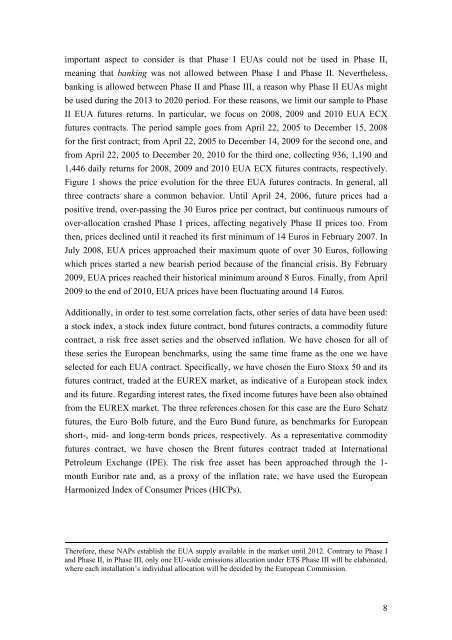You also want an ePaper? Increase the reach of your titles
YUMPU automatically turns print PDFs into web optimized ePapers that Google loves.
important aspect to consider is that Phase I EUAs could not be used in Phase II,<br />
meaning that banking was not allowed between Phase I and Phase II. Nevertheless,<br />
banking is allowed between Phase II and Phase III, a reason why Phase II EUAs might<br />
be used during the 2013 to 2020 period. For these reasons, we limit our sample to Phase<br />
II EUA futures returns. In particular, we focus on 2008, 2009 and 2010 EUA ECX<br />
futures contracts. The period sample goes from April 22, 2005 to December 15, 2008<br />
for the first contract; from April 22, 2005 to December 14, 2009 for the second one, and<br />
from April 22, 2005 to December 20, 2010 for the third one, collecting 936, 1,190 and<br />
1,446 daily returns for 2008, 2009 and 2010 EUA ECX futures contracts, respectively.<br />
Figure 1 shows the price evolution for the three EUA futures contracts. In general, all<br />
three contracts share a common behavior. Until April 24, 2006, future prices had a<br />
positive trend, over-passing the 30 Euros price per contract, but continuous rumours of<br />
over-allocation crashed Phase I prices, affecting negatively Phase II prices too. From<br />
then, prices declined until it reached its first minimum of 14 Euros in February 2007. In<br />
July 2008, EUA prices approached their maximum quote of over 30 Euros, following<br />
which prices started a new bearish period because of the financial crisis. By February<br />
2009, EUA prices reached their historical minimum around 8 Euros. Finally, from April<br />
2009 to the end of 2010, EUA prices have been fluctuating around 14 Euros.<br />
Additionally, in order to test some correlation facts, other series of data have been used:<br />
a stock index, a stock index future contract, bond futures contracts, a commodity future<br />
contract, a risk free asset series and the observed inflation. We have chosen for all of<br />
these series the European benchmarks, using the same time frame as the one we have<br />
selected for each EUA contract. Specifically, we have chosen the Euro Stoxx 50 and its<br />
futures contract, traded at the EUREX market, as indicative of a European stock index<br />
and its future. Regarding interest rates, the fixed income futures have been also obtained<br />
from the EUREX market. The three references chosen for this case are the Euro Schatz<br />
futures, the Euro Bolb future, and the Euro Bund future, as benchmarks for European<br />
short-, mid- and long-term bonds prices, respectively. As a representative commodity<br />
futures contract, we have chosen the Brent futures contract traded at International<br />
Petroleum Exchange (IPE). The risk free asset has been approached through the 1-<br />
month Euribor rate and, as a proxy of the inflation rate, we have used the European<br />
Harmonized Index of Consumer Prices (HICPs).<br />
Therefore, these NAPs establish the EUA supply available in the market until 2012. Contrary to Phase I<br />
and Phase II, in Phase III, only one EU-wide emissions allocation under ETS Phase III will be elaborated,<br />
where each installation’s individual allocation will be decided by the European Commission.<br />
8

















